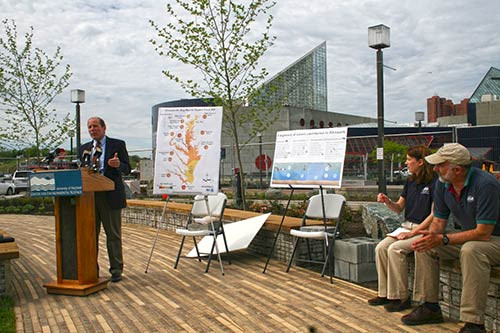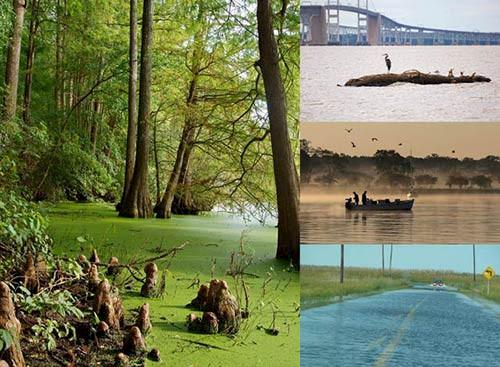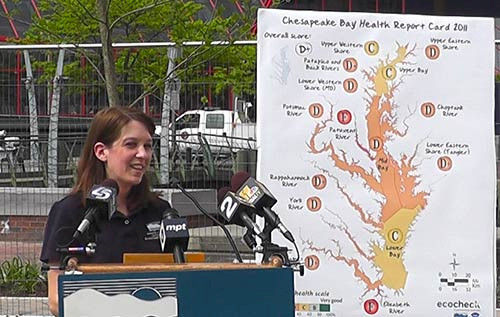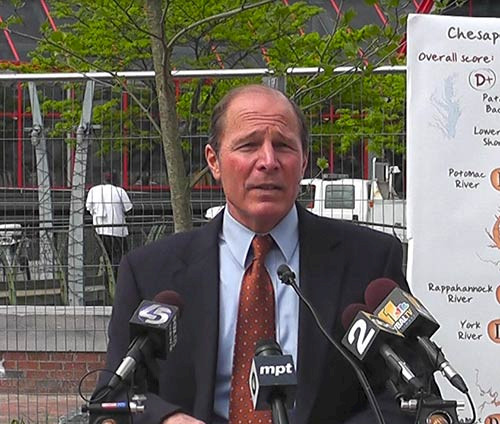Chesapeake Bay 2011 report card release at Baltimore Harbor
Bill Dennison ·The following remarks were made at the 17 April 2012 release of the Chesapeake Bay report card:
Welcome to the 2011 Chesapeake Bay report card release. My name is Bill Dennison, and I am with the University of Maryland Center for Environmental Science or UMCES. For the past six years, a group of scientists associated with a partnership that we formed between UMCES and NOAA called EcoCheck has been producing annual report cards for Chesapeake Bay. In addition, EcoCheck scientists have been working with various riverkeeper and waterkeeper groups in the region to develop scientifically rigorous report cards at a more detailed level. We are here today to present the 2011 report card results but also to celebrate some of the activities that various groups are engaged in to begin to improve these report card scores. We have two other speakers lined up for today, and they will make short remarks relating to the report card and the societal response to the scores. I will present the overall report card scores and Caroline Wicks, the EcoCheck project manager will follow up with details about the scores. Following Caroline, we have Nick DiPasquale, Director of the Chesapeake Bay Program to talk about the federal government’s involvement in the restoration of the magnificent Chesapeake Bay.

I also would like to acknowledge some of our colleagues attending today from various organizations in the Chesapeake Bay region. Dr. Bob Summers, Maryland Secretary of the Environment, has been leading the effort to upgrade sewage treatment facilities throughout Maryland and works with Maryland Governor Martin O’Malley in the BayStat initiative to track and accelerate progress in Bay restoration. Laurie Schwartz and Adam Lindquist from the Waterfront Partnership, an interesting consortium of business, government and non-government organizations and individuals who are leading the effort to restore Baltimore Harbor.
Today we have gathered in the shadow of this building which houses the Institute for Marine and Environmental Technology, a consortium of three universities, UMCES, University of Maryland Baltimore County and University of Maryland Baltimore. In this building, led by Acting Director Dr. Russell Hill, there are some very clever and committed faculty and students who are working to harness modern scientific techniques to help solve environmental problems.
In addition, we have chosen to launch the report card in this wonderful new park which also serves as a stormwater treatment system so that the runoff from the surrounding pavement and roofs does not directly enter Baltimore Harbor, but percolates into the ground, recharging the groundwater levels and effectively treating the water. This park illustrates what a group of concerned people can accomplish and was spearheaded by the Waterfront Partnership, an organization of business leaders, government officials, and non-profit organization volunteers and staff dedicated to the goal of a swimmable and fishable Baltimore Harbor by 2020. The official opening of Pierce’s Park will by on May 6 at 2 pm. In addition, a large floating wetlands project will be launched this Friday in front of the World Trade Center.

A novel approach we developed for this year’s report card release was a photo contest for the report card cover. The photograph of a Bald Cypress swamp in the headwaters of the Nanticoke River, Delaware by Benjamin Reed won first place. This beautiful photograph illustrates the diversity of habitats and relatively pristine conditions of some regions within the Chesapeake watershed. The second place photograph taken in Town Creek off the Choptank River, Maryland by Jim Kidd was an iconic watermen photograph, illustrating the long and important connection between people and Chesapeake Bay. Two third place photos included a photograph by Guy Willey, Sr. of a submerged road in southern Dorchester County, Maryland, dramatically depicts the vulnerability of the Chesapeake Bay to climate change and sea level rise. The other third place photo was by Danny Poet just south of the Chesapeake Bay bridge in the mainstem of the Bay. This photo of a Great Blue Heron perched on a log floating provides a reminder that last year’s conditions were influenced to large degree by unusually high water flows from the Susquehanna River. There is a high likelihood that the tree in the photograph is of Pennsylvania origin.

The report card score for 2011 was an overall D+, which is the second lowest score that we have recorded since 1986, the furthest back that we have been able to calculate scores. The only worse score was in 2003, another year of extremely high freshwater flows. This is obviously not good news for Chesapeake Bay and it occurs in spite of some very positive efforts in terms of restoration efforts.
The 2011 report card grades ranged from three Cs (Upper Bay, Lower Bay and Upper Western Shore to two Fs (Elizabeth and Patuxent Rivers). The 2011 scores dropped compared with 2010 scores in 13 of the 15 reporting regions. The only two regions to show slight improvements were the Patapsco and Back Rivers and the rivers just to the south of here in Anne Arundel County.
What accounted for such poor scores last year? We believe that a sequence of events contributed to the poor health in 2011. It started with a particularly wet spring which flushed large amounts of nutrients and sediments into the Bay. Based on these spring time conditions, our scientific colleagues at Johns Hopkins University and UMCES provided an accurate ecological forecast of poor to very poor dissolved oxygen conditions. As well, the runoff led to murky water which lasted all summer. The spring flows were followed by a hot, dry summer and the strong stratification of warm, fresher water on top of cool, salty water prevented oxygen from reaching bottom waters. We had a well developed and persistent zone of low oxygen bottom waters (the so-called ‘dead zone’). Near the end of the summer we had Hurricane Irene which thoroughly mixed the Bay and broke up the persistent low oxygen zone, which was not bad for the Bay. But Irene was followed by Tropical Storm Lee which generated high water flows, particularly down the mighty Susquehanna River. This brought tons of sediment into the Bay (an inch and a half of sediment blanketed the upper Bay) and more nutrients into the Bay, setting up unusual low oxygen conditions into autumn.
Caroline Wicks from EcoCheck provided details of the different indicators and the relationship between the sequence of weather events and the resulting report card scores. Nick DiPasquale from the Chesapeake Bay Program provided an overview of the Watershed Implementation Plans (WIPs) and the regulatory framework, but also emphasized the partnership activities occurring throughout the watershed.


We wrapped up by congratulating the strong environmental initiatives recently enacted by the Maryland General Assembly and are hopeful that Virginia and Pennsylvania will follow suit. We thanked the dozens of scientists who collect, analyze and interpret the data used in the report card. We ended with the hope is that this will be the worst report card score that we will ever report—that the record cover crops planted last fall by Maryland farmers and the accelerated sewage treatment upgrades will soon be manifested in improving report card scores in the future.
About the author
Bill Dennison

Dr. Bill Dennison is a Professor of Marine Science and Vice President for Science Application at the University of Maryland Center for Environmental Science.